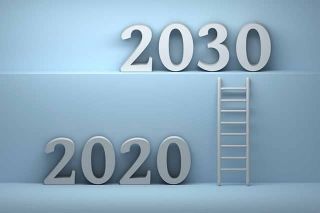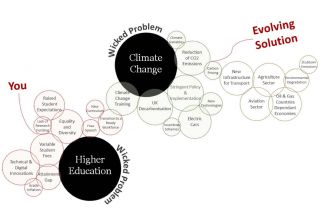
www.buildingsandcities.org/insights/commentaries/academia-climate-change.html
Academia's Critical Role in Climate Change

Providing students with the education and deep understanding of the issues and capabilities is now even more crucial
Edward
Mazria and Lindsay
Rasmussen of Architecture 2030
respond to the B&C special issue EDUCATION
& TRAINING: MAINSTREAMING ZERO CARBON. Professional design schools can provide the leadership needed
to address what is this century's greatest challenge - the preservation of a
habitable planet. Providing
students with new knowledge and capabilities is now even more critical if we are to act responsibly to stay within a 1.5˚C budget. 5 broad challenges for higher education are presented.
We are in the midst of many US and global calamities - climate change, COVID-19, and environmental, racial, and social injustices - each demanding immediate and sustained action. While 2020 has been an extremely challenging year, it has also been a year met by an increased awareness of these issues, as well as new innovations, dialog and achievements in addressing them.
Recent climate action has been motivated by accelerating global climatic impacts and an understanding of the dramatic difference between a 1.5˚C global warming limit and a 2˚C limit, and the global CO2 emission budgets (Rogelj et al., 2018) for meeting the 1.5˚C threshold. According to the IPCC, the global carbon budget, or the total amount of CO2 that can be released into the atmosphere while maintaining a good, or 67% probability, of limiting warming to 1.5˚C is now about 340 GtCO2. To meet this budget, global CO2 emissions must be reduced by 65% by 2030, and CO2 emissions completely phased out by 2040.
The good news is, if we act quickly and responsibly, we can stay within the 1.5˚C budget. We have all the tools, policies, strategies, products, and affordable renewable energy needed to do so as outlined in the International Energy Agency's World Energy Outlook 2020 which tracks energy production and consumption worldwide (Carbon Brief, 2020).
Governments are beginning to address these new targets. In December 2020 the UK Prime Minister announced their new target that aligns with the IPCC SR15 report, calling for a reduction in UK's emissions by at least 68% by 2030, compared to 1990 levels (BEIS, 2020). Bold action is also being taken to address embodied carbon in construction as Oslo, Los Angeles, Mexico City, and Budapest commit to emissions reductions through the C40 Clean Construction Declaration, 'pledging to work with industry to, at a minimum, halve emissions from construction projects in their cities by 2030' (C40, 2020).
While significant action is currently underway in the profession, a paralleled action must now be accelerated within academia. Providing students with the education and deep understanding of the issues and tools they need as they enter the workforce is now even more critical.
Professional design schools are well poised to provide the leadership in higher education needed to address what we deem to be this century's greatest challenge - the preservation of a habitable planet. Schools serve as unique laboratories for structuring an integrated response to complex physical, ecological, social, and economic concerns; and they can do so at a scale that is manageable, yet large enough to make a discernible difference. Focusing on the important role and positive impact education and training plays in meeting the Paris Agreement's targets, addressing current and future climate impacts, and moving beyond zero-carbon to create Carbon Positive and socially just built environments will instill a sense of purpose and excitement in meeting the challenges of our time.
We specifically suggest that professional program core design studios immediately:
- promote a deep understanding of the relationship between built and natural environments
- reach across disciplines to cultivate a broader understanding of design and planning issues and solutions
- engage social and environmental equity issues that recognize the consequences of design decisions
- connect students with the profession by bringing in working professionals actively designing zero carbon buildings
- incorporate zero carbon baseline requirements for all studio design projects.
An abundance of positive examples already exist in both academia and the design professions. The Buildings & Cities special issue shows how education and training can develop 'the capacities, capabilities and competences to rapidly decarbonize both new construction and the existing building stock' (Stevenson and Kwok, 2020). Authors dive into issues of policy and cross-disciplinary collaboration, as well as passive design strategies, embodied carbon and the importance of reuse, recycling, and re-manufacturing of building products. Authors also address the need for addressing issues holistically, expanding beyond fundamentals of zero-carbon design and into social issues. We recommend using this special issue of Buildings & Cities as a stepping point for further action, collaboration, and conversations.
References
BEIS (2020) UK sets ambitious new climate target ahead of UN Summit. Press release from UK Department for Business, Energy and Industrial Strategy. https://www.gov.uk/government/news/uk-sets-ambitious-new-climate-target-ahead-of-un-summit
Carbon Brief (2020). Solar is now 'cheapest electricity in history', confirms IEA. https://www.carbonbrief.org/solar-is-now-cheapest-electricity-in-history-confirms-iea
C40 Cities (2020) Oslo, Los Angeles, Mexico City and Budapest Commit to Clean Construction, Moving the Industry Towards a Sustainable Future. Press release from C40 Cities. https://www.c40.org/press_releases/clean-construction-declaration-launch
Rogelj, J., D. Shindell, K. Jiang, S. Fifita, P. Forster, V. Ginzburg, C. Handa, H. Kheshgi, S. Kobayashi, E. Kriegler, L. Mundaca, R. Séférian, and M.V.Vilariño (2018). Mitigation Pathways Compatible with 1.5°C in the Context of Sustainable Development. In: Global Warming of 1.5°C. An IPCC Special Report on the impacts of global warming of 1.5°C above pre-industrial levels and related global greenhouse gas emission pathways, in the context of strengthening the global response to the threat of climate change, sustainable development, and efforts to eradicate poverty [Masson-Delmotte, V., P. Zhai, H.-O. Pörtner, D. Roberts, J. Skea, P.R. Shukla, A. Pirani, W. Moufouma-Okia, C. Péan, R. Pidcock, S. Connors, J.B.R. Matthews, Y. Chen, X. Zhou, M.I. Gomis, E. Lonnoy, T. Maycock, M. Tignor, and T. Waterfield (eds.)]. Geneva: IPCC and WMO. https://www.ipcc.ch/sr15/
Stevenson, F., & Kwok, A. (2020). Mainstreaming zero carbon: lessons for built-environment education and training. Buildings and Cities, 1(1), pp. 687-696., p. 687. DOI: https://doi.org/10.5334/bc.84
Latest Peer-Reviewed Journal Content
Designing for pro-environmental behaviour change: the aspiration–reality gap
J Simpson & J Uttley
Lifetimes of demolished buildings in US and European cities
J Berglund-Brown, I Dobie, J Hewitt, C De Wolf & J Ochsendorf
Expanding the framework of urban living labs using grassroots methods
T Ahmed, I Delsante & L Migliavacca
Youth engagement in urban living labs: tools, methods and pedagogies
N Charalambous, C Panayi, C Mady, T Augustinčić & D Berc
Co-creating urban transformation: a stakeholder analysis for Germany’s heat transition
P Heger, C Bieber, M Hendawy & A Shooshtari
Placemaking living lab: creating resilient social and spatial infrastructures
M Dodd, N Madabhushi & R Lees
Church pipe organs: historical tuning records as indoor environmental evidence
B Bingley, A Knight & Y Xing
A framework for 1.5°C-aligned GHG budgets in architecture
G Betti, I Spaar, D Bachmann, A Jerosch-Herold, E Kühner, R Yang, K Avhad & S Sinning
Net zero retrofit of the building stock [editorial]
D Godoy-Shimizu & P Steadman
Co-learning in living labs: nurturing civic agency and resilience
A Belfield
The importance of multi-roles and code-switching in living labs
H Noller & A Tarik
Researchers’ shifting roles in living labs for knowledge co-production
C-C Dobre & G Faldi
Increasing civic resilience in urban living labs: city authorities’ roles
E Alatalo, M Laine & M Kyrönviita
Co-curation as civic practice in community engagement
Z Li, M Sunikka-Blank, R Purohit & F Samuel
Preserving buildings: emission reductions from circular economy strategies in Austria
N Alaux, V Kulmer, J Vogel & A Passer
Urban living labs: relationality between institutions and local circularity
P Palo, M Adelfio, J Lundin & E Brandão
Living labs: epistemic modelling, temporariness and land value
J Clossick, T Khonsari & U Steven
Co-creating interventions to prevent mosquito-borne disease transmission in hospitals
O Sloan Wood, E Lupenza, D M Agnello, J B Knudsen, M Msellem, K L Schiøler & F Saleh
Circularity at the neighbourhood scale: co-creative living lab lessons
J Honsa, A Versele, T Van de Kerckhove & C Piccardo
Positive energy districts and energy communities: how living labs create value
E Malakhatka, O Shafqat, A Sandoff & L Thuvander
Built environment governance and professionalism: the end of laissez-faire (again)
S Foxell
Co-creating justice in housing energy transitions through energy living labs
D Ricci, C Leiwakabessy, S van Wieringen, P de Koning & T Konstantinou
HVAC characterisation of existing Canadian buildings for decarbonisation retrofit identification
J Adebisi & J J McArthur
Simulation and the building performance gap [editorial]
M Donn
Developing criteria for effective building-sector commitments in nationally determined contributions
P Graham, K McFarlane & M Taheri
Join Our Community

The most important part of any journal is our people – readers, authors, reviewers, editorial board members and editors. You are cordially invited to join our community by joining our mailing list. We send out occasional emails about the journal – calls for papers, special issues, events and more.
We will not share your email with third parties. Read more



Latest Commentaries
COP30 Report
Matti Kuittinen (Aalto University) reflects on his experience of attending the 2025 UN Conference of the Parties in Belém, Brazil. The roadmaps and commitments failed to deliver the objectives of the 2025 Paris Agreement. However, 2 countries - Japan and Senegal - announced they are creating roadmaps to decarbonise their buildings. An international group of government ministers put housing on the agenda - specifying the need for reduced carbon and energy use along with affordability, quality and climate resilience.
Building-Related Research: New Context, New Challenges
Raymond J. Cole (University of British Columbia) reflects on the key challenges raised in the 34 commissioned essays for Buildings & Cities 5th anniversary. Not only are key research issues identified, but the consequences of changing contexts for conducting research and tailoring its influence on society are highlighted as key areas of action.